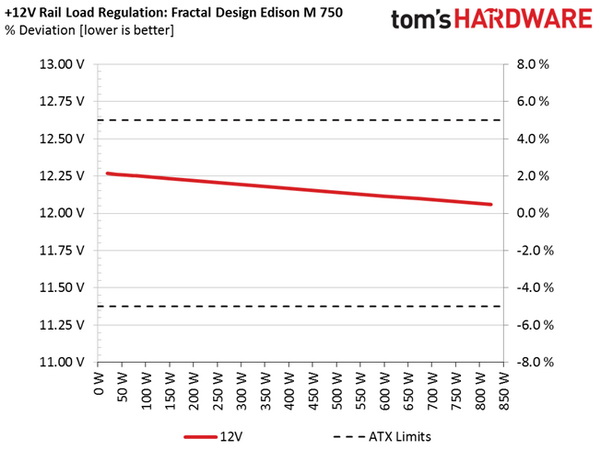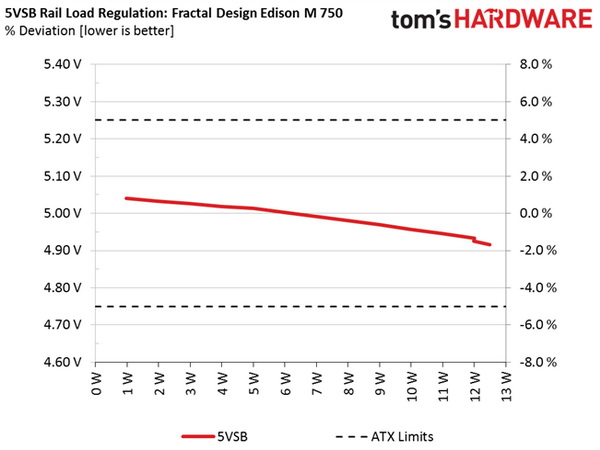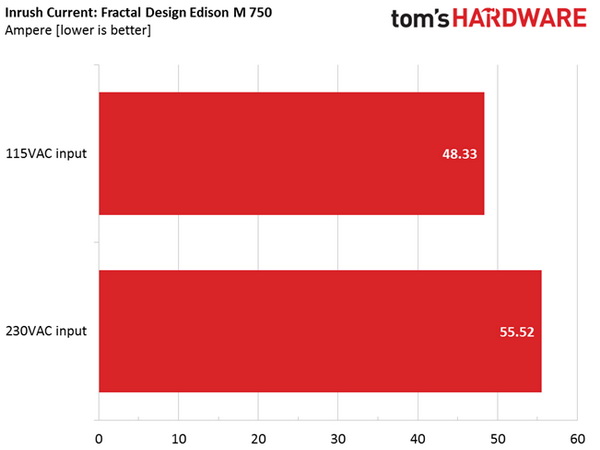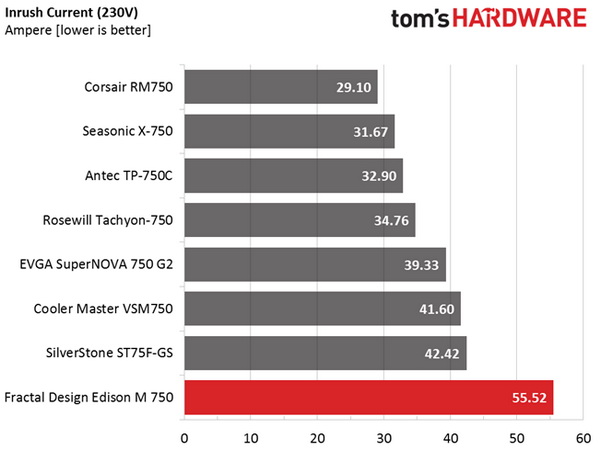Fractal Design Edison M Series 750W Power Supply Review
Why you can trust Tom's Hardware
Load Regulation, Hold-Up Time And Inrush Current
To learn more about our PSU tests and methodology, please check out How We Test Power Supply Units.
Primary Rails And 5VSB Load Regulation
Load Regulation testing is detailed here.
The following charts show the voltage values of the main rails recorded over a range from 40W to the maximum specified load, and the deviation (in percent) for the same load range. You will also find a chart showing how the 5VSB rail deals with the load we throw at it.








Hold-Up Time
Our hold-up time tests are described in detail here.


The hold-up time was right on target at 16ms. While a larger APFC cap can offer prolonged hold-up time, it also affects efficiency and increases the PSU's cost, so it's preferable to use the corresponding component in this section.
Inrush Current
For details on our inrush current testing, please click here.


The registered inrush current was much higher than we expected. We would like to see lower readings with both 115V and 230V input.
Get Tom's Hardware's best news and in-depth reviews, straight to your inbox.
Load Regulation And Efficiency Measurements
The first set of tests reveals the stability of the voltage rails and the PSU's efficiency. The applied load equals (approximately) 10 to 110 percent of the maximum load the supply can handle, in increments of 10 percentage points.
We conducted two additional tests. During the first, we stressed the two minor rails (5V and 3.3V) with a high load while the load at +12V was only 0.10A. This test reveals whether the PSU is Haswell-ready or not. In the second test, we determined the maximum load the +12V rail could handle while the load on the minor rails was minimal.
| Test | 12V | 5V | 3.3V | 5VSB | PowerDC/AC(W) | Efficiency(%) | Fan NoisedB(A) | TempIn/Out(°C) | PF/AC(V) |
|---|---|---|---|---|---|---|---|---|---|
| 1 | 4.344A | 1.963A | 1.959A | 0.996A | 74.80 | 82.82 | 30.5 | 37.24 | 0.976 |
| 12.253V | 5.093V | 3.367V | 5.013V | 90.32 | 42.02 | 115.0 | |||
| 2 | 9.719A | 2.937A | 2.949A | 1.196A | 149.68 | 87.72 | 30.5 | 38.77 | 0.995 |
| 12.232V | 5.088V | 3.354V | 5.002V | 170.64 | 44.08 | 115.0 | |||
| 3 | 15.459A | 3.444A | 3.465A | 1.400A | 224.88 | 89.25 | 32.9 | 39.01 | 0.995 |
| 12.214V | 5.083V | 3.344V | 4.992V | 251.98 | 44.87 | 115.0 | |||
| 4 | 21.205A | 3.933A | 3.955A | 1.605A | 299.73 | 89.67 | 35.6 | 39.57 | 0.996 |
| 12.194V | 5.077V | 3.336V | 4.981V | 334.26 | 45.88 | 115.0 | |||
| 5 | 26.636A | 4.932A | 4.964A | 1.811A | 374.74 | 89.45 | 40.8 | 41.30 | 0.997 |
| 12.174V | 5.070V | 3.321V | 4.970V | 418.92 | 47.86 | 115.0 | |||
| 6 | 32.077A | 5.921A | 5.982A | 2.015A | 449.56 | 89.10 | 46.9 | 42.37 | 0.997 |
| 12.154V | 5.064V | 3.308V | 4.956V | 504.57 | 49.17 | 114.9 | |||
| 7 | 37.536A | 6.918A | 7.012A | 2.221A | 524.56 | 88.58 | 47.0 | 43.43 | 0.997 |
| 12.135V | 5.059V | 3.294V | 4.945V | 592.22 | 50.55 | 114.9 | |||
| 8 | 43.013A | 7.910A | 8.044A | 2.431A | 599.48 | 87.98 | 47.2 | 43.81 | 0.998 |
| 12.115V | 5.054V | 3.282V | 4.933V | 681.35 | 51.18 | 114.9 | |||
| 9 | 48.929A | 8.424A | 8.587A | 2.435A | 674.48 | 87.37 | 47.2 | 45.21 | 0.998 |
| 12.098V | 5.048V | 3.271V | 4.925V | 772.00 | 52.82 | 114.9 | |||
| 10 | 54.824A | 8.924A | 9.104A | 2.540A | 749.27 | 86.57 | 47.3 | 46.35 | 0.998 |
| 12.079V | 5.042V | 3.262V | 4.915V | 865.50 | 54.19 | 114.9 | |||
| 11 | 61.121A | 8.935A | 9.119A | 2.545A | 824.2 | 85.57 | 47.3 | 48.23 | 0.998 |
| 12.059V | 5.037V | 3.256V | 4.908V | 963.20 | 57.01 | 114.9 | |||
| CL1 | 0.098A | 12.008A | 12.006A | 0.004A | 101.78 | 81.86 | 40.1 | 43.27 | 0.985 |
| 12.247V | 5.090V | 3.285V | 5.022V | 124.34 | 49.67 | 115.0 | |||
| CL2 | 61.942A | 1.003A | 1.003A | 1.002A | 761.73 | 86.92 | 47.3 | 46.70 | 0.998 |
| 12.081V | 5.046V | 3.328V | 4.966V | 876.35 | 54.70 | 114.9 |
The output noise stayed at low levels at up to the 40-percent load test, and only exceeding the 40 dB(A) mark when we dialed in a 375W load. At higher loads and under really tough conditions, the fan's noise will be annoying for many users. This could have been avoided if Fractal Design used a larger-diameter fan capable of pushing the same amount of air, but at lower speeds.
In the load regulation area, the +12V and 5V rails were within two-percent deviation. The 3.3V rail didn't do as well; it exceeded three percent. While we would like to see all rails within two percent, this isn't a high-end platform, so the pursuit of top performance wasn't the first priority of Fractal Design's designers.
According to the 80 PLUS Gold certification, efficiency should meet or exceed 87 percent at light load, 90 percent at typical load and 87 percent at full load. What the 80 PLUS organization means is 20 percent, 50 percent and 100 percent of the unit's max-rated capacity at typical and full loads. As you can see from the table above, the Edison M 750W PSU doesn't quite meet the minimum requirements with typical and full load. We should stress however, that the 80 PLUS tests are conducted at much lower operating temperatures, allowing for higher efficiency levels.
Current page: Load Regulation, Hold-Up Time And Inrush Current
Prev Page A Look Inside And Component Analysis Next Page Efficiency, Temperatures And Noise
Aris Mpitziopoulos is a contributing editor at Tom's Hardware, covering PSUs.
-
maxwellmelon there are several issues with there testing. first power good signal is not a good base for testing as its simple to "Cheat" the 16ms hold up.how about actually watching power good vs output voltages also. also the thermal camera scall changes every time how about using a fix scale as modifying scales leads to making things show hot that are not really that hot.Reply -
Aris_Mp First of all I measure AC loss to PWR_OK hold-up time since it is much easier to show it in my graphs and explain it. For me it is as easy to measure "AC loss to PWR_OK hold-up time" plus "PWR_OK inactive to DC loss delay" but I prefer it the way I do it.Reply
Also where do you base this? That the PG signal is simple to cheat and the manufacturers actually do this? From the moment the mainboards take seriously into account PG if this was the case then most likely there would be huge problems with lots of them. According to the ATX spec PG is de-asserted to a low state when any of the main rails falls out of 5% v. reg. Simply as that.
It just gives room for 1 ms till the PG signal sees the change at least in the ATX spec.
As for the thermal camera how it can show things hotter than it is? The scale is for this reason and from the moment the camera sees something from a different angle and a different region the scale is changing automatically. Nothing I can do about it. This is why I provide also actual temperature readings on all IR images.
-
PaulBags A quick opinion on the edison vs similar range seasonic own brand would be nice. Is it a new design, or an exact rebrand of a seasonic design? Quality of components vs?Reply -
Aris_Mp This is based on the same platform with the Seasonic G series and I state this in the "look inside" page. I haven't tested the G750 so far but I believe that since they are based on the same platform performance will be similar. Seasonic might used Enesol polymer caps (something that they usually do in their G units) instead of Chemi-Cons that Fractal chose, but both cap brands are very good so don't expect to see any real performance difference on them (although I prefer Chemi-Cons).Reply
So the design is nothing new and this is a Seasonic rebrand with minor differences at the internals (most likely the caps selection as I stated above). -
Aris_Mp Forgot to mention that besides caps the cooling fan is also different since on all Seasonic G units that I have tested so far have an ADDA double-ball bearing fan while the Edison PSU uses an FDB fan. However lately I noticed that many Seasonic units use Hong Hua FDB fans instead of ADDA double-ball bearing ones, so it is possible that this change might have affected the new bunches of G units.Reply -
Sakkura You say that you'd prefer if the unit was fully modular, but I don't really see the point.Reply
The fixed cables are the ones that will always be in use for any system using a 750W power supply, so the ability to disconnect those cables would not be beneficial. In fact it would lead to higher cost and also an extra point of failure and a slight loss of efficiency since a connector can never quite match an uninterrupted cable. -
Aris_Mp fully modular cables provide easier installation and cable management. Also you can easily change them with longer/shorter ones if you like or replace them in case there is a problem with them or simply you want something fancier.Reply
Loss of efficiency isn't a reason any more, on the contrary with bus bars or thick cables transferring power to the modular PCB energy losses can be minimized. In addition no cables block the secondary side caps, something that besides increasing their lifetime also allows for more relaxed fan profiles and better airflow inside the chassis.
Also the cost of a semi-modular to fully modular isn't high and in a 750 W PSU that costs 140 bucks already the cost reason doesn't stand (for fully modular design). -
Sakkura Reply
No they don't. The connector on the power supply end adds complexity and reduces cable flexibility.15924995 said:fully modular cables provide easier installation and cable management. Also you can easily change them with longer/shorter ones if you like or replace them in case there is a problem with them or simply you want something fancier.
You cannot easily change them because other cables are often incompatible - there is no common standard for modular PSU cables. Using incompatible cables can be downright dangerous. Here is a cautionary tale. -
Aris_Mp I didn't say that you can change them with anything, did I? Also it is common sense that every manufacturer uses their one design on modular cables. Thing is that with modular PSUs you can get an extra cable kit since most manufacturers sell one for their PSUs (e.g. Corsair, EVGA).Reply
Also I still cannot understand how the connector on the PSU end adds complexity and reduces cable flexibility! Cable flexibility depends on the gauges' thickness and not on the cables modularity design (or not).
Anyway I believe I made my opinion clear on why I prefer fully-modular PSUs.